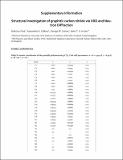Files in this item
Structural investigation of graphitic carbon nitride via XRD and neutron diffraction
Item metadata
| dc.contributor.author | Fina, Federica | |
| dc.contributor.author | Callear, Samantha | |
| dc.contributor.author | Carins, George Michael | |
| dc.contributor.author | Irvine, John Thomas Sirr | |
| dc.date.accessioned | 2016-03-23T00:01:00Z | |
| dc.date.available | 2016-03-23T00:01:00Z | |
| dc.date.issued | 2015-04-14 | |
| dc.identifier | 179180263 | |
| dc.identifier | f34b1b4d-650f-4882-864b-2a6c25c3ba08 | |
| dc.identifier | 84927732714 | |
| dc.identifier | 000353176100043 | |
| dc.identifier.citation | Fina , F , Callear , S , Carins , G M & Irvine , J T S 2015 , ' Structural investigation of graphitic carbon nitride via XRD and neutron diffraction ' , Chemistry of Materials , vol. 27 , no. 7 , pp. 2612-2618 . https://doi.org/10.1021/acs.chemmater.5b00411 | en |
| dc.identifier.issn | 0897-4756 | |
| dc.identifier.other | ORCID: /0000-0003-2594-350X/work/31348248 | |
| dc.identifier.other | ORCID: /0000-0002-8394-3359/work/68280802 | |
| dc.identifier.uri | https://hdl.handle.net/10023/8464 | |
| dc.description | We thank EPSRC for support through the EPSRC/NSF chemistry programme and the Royal Society for a Wolfson Merit award. | en |
| dc.description.abstract | Graphitic carbon nitride (g-C3N4) has, since 2009, attracted great attention for its activity as a visible-light-active photocatalyst for hydrogen evolution. Since it was synthesized in 1834, g-C3N4 has been extensively studied both catalytically and structurally. Although its 2D structure seems to have been solved, its 3D crystal structure has not yet been confirmed. This study attempts to solve the 3D structure of graphitic carbon nitride by means of X-ray diffraction and of neutron scattering. Initially, various structural models are considered and their XRD patterns compared to the measured one. After selecting possible candidates as g-C3N4 structure, neutron scattering is employed to identify the best model that describes the 3D structure of graphitic carbon nitride. Parallel chains of tri-s-triazine units organized in layers with an A–B stacking motif are found to describe the structure of the synthesized graphitic carbon nitride well. A misalignment of the layers is favorable because of the decreased π–π repulsive interlayer interactions. | |
| dc.format.extent | 703304 | |
| dc.format.extent | 746751 | |
| dc.language.iso | eng | |
| dc.relation.ispartof | Chemistry of Materials | en |
| dc.subject | QD Chemistry | en |
| dc.subject | NDAS | en |
| dc.subject.lcc | QD | en |
| dc.title | Structural investigation of graphitic carbon nitride via XRD and neutron diffraction | en |
| dc.type | Journal article | en |
| dc.contributor.sponsor | The Royal Society | en |
| dc.contributor.sponsor | EPSRC | en |
| dc.contributor.sponsor | EPSRC | en |
| dc.contributor.institution | University of St Andrews. School of Chemistry | en |
| dc.contributor.institution | University of St Andrews. EaSTCHEM | en |
| dc.identifier.doi | https://doi.org/10.1021/acs.chemmater.5b00411 | |
| dc.description.status | Peer reviewed | en |
| dc.date.embargoedUntil | 2016-03-23 | |
| dc.identifier.url | http://pubs.acs.org/doi/suppl/10.1021/acs.chemmater.5b00411 | en |
| dc.identifier.grantnumber | WRMA 2012/R2 | en |
| dc.identifier.grantnumber | EP/H004130/1 | en |
| dc.identifier.grantnumber | EP/I038950/1 | en |
This item appears in the following Collection(s)
Items in the St Andrews Research Repository are protected by copyright, with all rights reserved, unless otherwise indicated.


